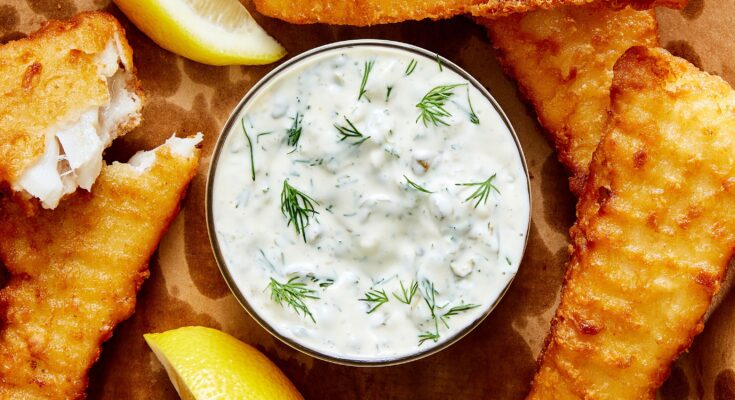Best Tartar Sauce Recipe: If you love seafood, then you know tartar sauce is the unsung hero of the dish. Creamy, tangy, with just the right balance of flavors—it can turn fried fish or shrimp from ordinary to unforgettable.
Instead of buying a jar full of preservatives, why not make your own tartar sauce at home? It’s easy, delicious, and can be customized to suit your taste perfectly.
Let’s dive into the ultimate tartar sauce recipe that’s about to become your go-to condiment.
What is Tartar Sauce?
Tartar sauce is a mayonnaise-based condiment that’s been a staple in kitchens across the globe—especially where seafood is loved. Typically flavored with pickles, capers, lemon juice, and sometimes herbs, this sauce is creamy, tangy, and refreshing. Think of it as the zesty, more exciting cousin of plain mayonnaise. What makes tartar sauce so great is how it cuts through the richness of fried or grilled seafood with its crisp, acidic notes.
But tartar sauce isn’t limited to seafood. Once you realize how delicious and easy it is to make, you’ll want to use it as a dip for veggies, fries, or even spread it on sandwiches. It’s versatile, it’s vibrant, and it’s downright addicting when done right.
History and Origin
Tartar sauce actually gets its name from the Tatars—a nomadic group from Central Asia. While the connection to the Tatars is more culinary than historical, French chefs coined the term “sauce tartare” as a nod to their raw meat dish known as steak tartare. Over time, the sauce evolved and crossed continents, eventually taking its familiar form in English-speaking countries with mayonnaise as the base.
In America, tartar sauce became popular in the mid-20th century, especially with the rise of fast-food fish sandwiches. Today, it’s a household name and a restaurant favorite.
Why Make It at Home?
Let’s face it—store-bought tartar sauces often taste artificial or overly sweet, and they’re filled with preservatives. When you make it at home, not only do you get a fresher flavor, but you also control every ingredient that goes in. Want it tangier? Add more lemon. Craving a spicy kick? Toss in some horseradish. Homemade tartar sauce is about as easy as mixing a few ingredients in a bowl, but the flavor payoff is huge.
Plus, homemade tartar sauce:
- Takes just 5 minutes to make
- Stores well for over a week
- Can be customized endlessly
Essential Ingredients
Core Ingredients You’ll Need
Here are the building blocks of a great tartar sauce:
- Mayonnaise: The creamy base. Use full-fat mayo for the best texture and flavor.
- Dill Pickles or Relish: Adds crunch and that signature tangy note. Use chopped dill pickles or dill relish for a classic flavor.
- Capers: Optional but highly recommended. Capers bring briny complexity and depth.
- Lemon Juice: Brightens the sauce and balances the richness of the mayo.
- Dijon Mustard: Adds a subtle bite and sharpness.
- Salt and Pepper: Basic seasoning to tie everything together.
Each of these ingredients plays a role in creating the perfect balance of creamy, tangy, and savory.
Optional Add-ins for Extra Flavor
Want to take your tartar sauce up a notch? Try adding these:
- Fresh Dill or Parsley: Brings a garden-fresh flavor.
- Minced Onion or Shallot: Adds sweetness and texture.
- Garlic Powder or Fresh Garlic: Enhances the savory depth.
- Hot Sauce or Horseradish: For a bit of heat.
- Sugar or Honey: To mellow out sharp flavors (use sparingly).
These aren’t mandatory, but they help tailor the sauce to your liking and can elevate a basic recipe into something truly restaurant-worthy.
Ingredient Substitutes and Tips
Not a fan of mayo? No problem. Greek yogurt or sour cream can step in as healthier alternatives. They’re tangy on their own, which means you might use a bit less lemon juice.
If you don’t have capers, a bit of extra pickle juice or chopped olives can work in a pinch. And for vegans, use a plant-based mayo—there are plenty of great ones out there.
A quick pro tip: Let the sauce sit in the fridge for at least 30 minutes before serving. This gives the flavors time to meld and intensify.
Step-by-Step Preparation
Step 1: Gathering Ingredients
Preparation is half the battle. Here’s what you’ll need for a small batch (about 1 cup):
Ingredients:
- 1 cup mayonnaise
- 1 tablespoon dill pickles (chopped) or dill relish
- 1 teaspoon capers (chopped)
- 1 teaspoon lemon juice
- 1 teaspoon Dijon mustard
- Salt and pepper to taste
Optional:
- 1 teaspoon minced fresh dill
- 1 teaspoon minced onion
- Dash of hot sauce or pinch of sugar (if needed)
Lay out all your ingredients before you start. Chop your pickles and capers finely to ensure they distribute evenly throughout the sauce. Having everything ready makes the mixing step go smoothly and ensures you don’t miss anything.
Step 2: Mixing and Balancing Flavors
Grab a medium-sized bowl and toss in your mayo, pickles, capers, lemon juice, mustard, and any optional add-ins you’re using. Use a spoon or whisk to mix everything together until it’s well combined.
Taste it. Need more tang? Add a splash more lemon. Want a bit more bite? Add mustard or a pinch of horseradish. Don’t be afraid to play around a little. Homemade sauces are all about customization.
Mixing should take no more than a minute, and once it’s done, your sauce is technically ready to eat. But don’t rush just yet.
Step 3: Resting the Sauce
This step is often skipped—but it makes a huge difference.
Transfer the sauce into a jar or airtight container and refrigerate it for at least 30 minutes. This chill time lets all the flavors meld into a creamy, harmonious blend. You’ll notice the sauce becomes thicker, more flavorful, and balanced after resting.
If you’re making it ahead of time (which is a great idea for parties or seafood dinners), you can store it in the fridge for up to 7 days.
Serving Suggestions
Best Foods to Pair With Tartar Sauce
Tartar sauce and seafood? That’s a classic combo you can’t go wrong with. But let’s go deeper. This creamy, tangy delight has more potential than most people realize. It’s a condiment powerhouse, and knowing what to pair it with will level up your meals.
Seafood Favorites:
- Fried Fish: Whether it’s cod, haddock, or tilapia, tartar sauce complements the crispy texture and rich flavor of fried fish perfectly.
- Fish Tacos: Add a spoonful of tartar sauce instead of regular sour cream or mayo for an exciting twist.
- Shrimp: Fried shrimp or grilled shrimp skewers become irresistible with a side of tartar.
- Crab Cakes: A must-have! Tartar sauce adds tang that cuts through the richness of the crab.
- Fish Sandwiches: Ever had a Filet-O-Fish? Tartar sauce is the heart of the flavor.
But Don’t Stop There…
- French Fries: Move over ketchup! Dip crispy fries into tartar sauce for a creamy, zingy experience.
- Fried Pickles or Zucchini: If you’re into Southern-style appetizers, tartar sauce makes the perfect creamy dip.
- Chicken Strips or Nuggets: It’s not just for fish—tartar sauce is awesome with fried or grilled chicken.
- Veggie Burgers: Slather it onto a veggie burger for a boost of bold flavor.
Tartar sauce is no one-trick pony. It’s the kind of condiment that quietly steals the show when paired well. Play around with it and you’ll start finding your own favorite combos.
Creative Uses Beyond Seafood
Think outside the sea—tartar sauce has the potential to be your new go-to spread or dip in the fridge.
Here are a few genius ideas:
- Sandwich Spread: Spread it on turkey, roast beef, or even grilled cheese sandwiches. It adds creamy richness and just the right zing.
- Salad Dressing Shortcut: Mix tartar sauce with a splash of vinegar or milk to make a quick creamy dressing for potato salads or green salads.
- Burger Sauce Base: Want a better burger sauce? Mix tartar sauce with a bit of ketchup and hot sauce. Boom—custom burger sauce!
- Deviled Eggs Filling: Swap half the mayo in your deviled egg recipe with tartar sauce. It’s unexpected but super delicious.
- Egg Salad Remix: Give your egg salad a fresh twist with tartar sauce instead of plain mayo. Trust me—once you try it, there’s no going back.
Bottom line? Tartar sauce is way more versatile than most people give it credit for. Once you make it fresh and see how easy it is to customize, you’ll start thinking up your own creative ways to use it.
Storage and Shelf Life
How to Store Tartar Sauce Properly
Homemade tartar sauce is free of preservatives, so storing it right is key to keeping it fresh and flavorful.
Tips for storage:
- Always keep it in an airtight container. A mason jar or resealable container with a tight-fitting lid works best.
- Store in the refrigerator, not at room temperature. The sauce contains mayo and other perishable ingredients.
- Don’t leave it sitting out for more than 2 hours, especially if serving at a party or BBQ.
If properly stored, your homemade tartar sauce will stay good for about 5 to 7 days. Just give it a quick stir before each use, as some separation is natural over time.
Tips to Maximize Freshness
Here are a few smart tricks to help your tartar sauce last as long as possible:
- Use clean utensils: Never double-dip! Always use a clean spoon or knife to scoop out what you need.
- Dry ingredients: Make sure your pickles or capers are drained well before mixing. Excess liquid can water down the sauce and reduce shelf life.
- Fresh herbs caution: If you’re adding fresh herbs like dill or parsley, they can shorten the shelf life. Either add them just before serving or consume the sauce within 3 days.
- Label the container: Write the date you made the sauce on the container lid so you know exactly how fresh it is.
Keeping these simple tips in mind can help prevent waste and ensure that every scoop of tartar sauce tastes just as good as the first.
Common Mistakes to Avoid
Even though making tartar sauce is super easy, a few common mistakes can mess up the texture or flavor. Here’s what to watch out for:
- Too much pickle juice: It might be tempting to pour in extra pickle brine for a tangy kick, but this can make your sauce runny and overly salty.
- Skipping the rest time: Tartar sauce needs time to chill in the fridge so the flavors meld. If you skip this step, it might taste flat or unbalanced.
- Not chopping finely enough: Big chunks of pickles or capers can ruin the smooth consistency. Always chop your mix-ins finely for the best texture.
- Using low-fat mayo: While healthier, low-fat or fat-free mayo doesn’t always provide the creamy mouthfeel that makes tartar sauce so satisfying. If you’re watching calories, Greek yogurt is a better substitute.
- Over-seasoning early: Add salt and pepper after tasting. Ingredients like capers and pickles already bring saltiness, so it’s easy to go overboard.
- Overmixing: While not a huge issue, vigorous mixing can cause the mayo to break down and get a bit greasy-looking. Gentle folding works best.
Avoid these common pitfalls, and your homemade tartar sauce will taste like it came straight from a fancy seafood restaurant.
Healthier Tartar Sauce Alternatives
Looking to cut calories without sacrificing taste? Good news—you can totally enjoy tartar sauce on a healthier diet. The classic version is delicious but heavy on mayo, which means higher fat and calorie content. But with a few smart swaps, you can lighten things up and still keep all that bold, tangy flavor.
Smart Substitutions
- Greek Yogurt Instead of Mayo: Use non-fat or low-fat Greek yogurt as your base. It’s thick, creamy, and has a natural tang that works great for tartar sauce. Plus, it adds protein!
- Low-Fat or Vegan Mayo: There are tons of plant-based and low-fat mayo options that taste just like the real thing. They’re a great alternative if you’re watching your fat intake or avoiding eggs.
- Avocado Base: Mash up ripe avocado and use it as a base with lemon juice and pickles for a super unique and healthy take on tartar sauce.
Flavor Without the Fat
Cutting calories doesn’t mean cutting flavor. Here’s how to pump up the taste without piling on the fat:
- Add fresh herbs like dill, chives, or parsley for flavor and freshness.
- Use garlic or onion powder to add depth.
- A splash of vinegar or lemon juice goes a long way in enhancing the taste.
- Consider a dash of hot sauce for a little kick.
Healthy Pairing Ideas
Pair your lighter tartar sauce with grilled seafood instead of fried. It’s excellent on:
- Grilled salmon or tilapia
- Steamed crab or shrimp
- Roasted veggie wraps
- Healthy grain bowls with quinoa and fish
You’ll be surprised at how satisfying—and guilt-free—a healthier tartar sauce can be when made right.
FAQs about Tartar Sauce Recipe
1. Can I freeze homemade tartar sauce?
No, freezing is not recommended. The mayonnaise base tends to separate when thawed, resulting in an unpleasant texture. Stick to refrigerating it for up to 7 days.
2. What type of pickles are best for tartar sauce?
Dill pickles are ideal for their tangy flavor. Avoid sweet pickles unless you prefer a sweeter sauce. You can also use dill relish for convenience.
3. How can I make vegan tartar sauce?
Use vegan mayonnaise as the base and make sure all add-ins like pickles or capers are plant-based. You can also use mashed avocado for a unique twist.
4. Can I use Miracle Whip instead of mayonnaise?
Yes, but note that Miracle Whip is sweeter and has a different flavor profile. It might change the overall taste of your tartar sauce.
5. Why does my tartar sauce taste bland?
It might need more acidity or salt. Try adding a bit more lemon juice or a pinch of salt to balance the flavors. Always taste and adjust!
Conclusion
There you have it—the ultimate guide to making the best tartar sauce at home. From its creamy texture to its zesty kick, tartar sauce is one of those condiments that brings dishes to life. And once you’ve tasted a homemade batch, there’s no going back to the store-bought stuff. Whether you’re slathering it on a fish sandwich, using it as a dip for fries, or mixing it into your deviled eggs, tartar sauce delivers on every level.
What’s even better? It’s ridiculously easy to make. With just a handful of ingredients and five minutes of prep time, you’ve got yourself a restaurant-quality sauce. Want it spicier, sweeter, lighter, or chunkier? Go for it. The beauty of tartar sauce is that it’s endlessly customizable to fit your taste and dietary needs.
So the next time you’re firing up some fish or need a quick dip to impress your guests, whip up a batch of homemade tartar sauce. It’s a small step that makes a big difference.



